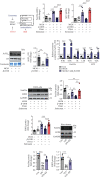Ketone Body β-Hydroxybutyrate Prevents Myocardial Oxidative Stress in Septic Cardiomyopathy
- PMID: 35340211
- PMCID: PMC8956399
- DOI: 10.1155/2022/2513837
Ketone Body β-Hydroxybutyrate Prevents Myocardial Oxidative Stress in Septic Cardiomyopathy
Abstract
Septic cardiomyopathy is a life-threatening complication of severe sepsis and septic shock. Oxidative stress and mitochondrial dysfunction have been identified as significant abnormalities in septic cardiomyopathy. However, specific treatments are rare. This study aims to investigate the impact of β-hydroxybutyrate (β-OHB) on septic cardiomyopathy and explore the underlying mechanism(s). We found that pretreatment of D-β-hydroxybutyrate-(R)-1,3 butanediol monoester (ketone ester, 3 mg/g body weight, once daily) by gavage for three days elevated the levels of ketone bodies, especially that of β-hydroxybutyrate (β-OHB) in the circulation and mouse hearts, which exerted a protective effect against lipopolysaccharide (LPS, 20 mg/kg)-induced septic cardiomyopathy in mice. In addition, an LPS-stimulated macrophage-conditioned medium (MCM) was used to mimic the pathological process of septic cardiomyopathy. Mechanistically, β-OHB alleviated myocardial oxidative stress and improved mitochondrial respiratory function through the antioxidant FoxO3a/MT2 pathway activated via histone deacetylase (HDAC) inhibition, which ultimately enhanced heart performance in septic cardiomyopathy. Our results, therefore, suggested an unappreciated critical role of β-OHB in septic heart protection as well as highlighted the potential of β-OHB as a simple remedy for the septic cardiomyopathy population.
Copyright © 2022 Liwei Ji et al.
Conflict of interest statement
The authors declare that they have no conflicts of interest.
Figures






Similar articles
-
[Effect of Ketone Body β-Hydroxybutyrate to Attenuate Inflammation-Induced Mitochondrial Oxidative Stress in Vascular Endothelial Cells].Sichuan Da Xue Xue Bao Yi Xue Ban. 2021 Nov;52(6):954-959. doi: 10.12182/20211160202. Sichuan Da Xue Xue Bao Yi Xue Ban. 2021. PMID: 34841761 Free PMC article. Chinese.
-
Ketone bodies alter dinitrophenol-induced glucose uptake through AMPK inhibition and oxidative stress generation in adult cardiomyocytes.Am J Physiol Endocrinol Metab. 2007 May;292(5):E1325-32. doi: 10.1152/ajpendo.00186.2006. Epub 2007 Jan 16. Am J Physiol Endocrinol Metab. 2007. PMID: 17227964
-
β-Hydroxybutyrate Exacerbates Hypoxic Injury by Inhibiting HIF-1α-Dependent Glycolysis in Cardiomyocytes-Adding Fuel to the Fire?Cardiovasc Drugs Ther. 2022 Jun;36(3):383-397. doi: 10.1007/s10557-021-07267-y. Epub 2021 Oct 15. Cardiovasc Drugs Ther. 2022. PMID: 34652582 Free PMC article.
-
Ketone Body, 3-Hydroxybutyrate: Minor Metabolite - Major Medical Manifestations.J Clin Endocrinol Metab. 2020 Sep 1;105(9):dgaa370. doi: 10.1210/clinem/dgaa370. J Clin Endocrinol Metab. 2020. PMID: 32525972 Review.
-
Mitochondrial Mechanisms in Septic Cardiomyopathy.Int J Mol Sci. 2015 Aug 3;16(8):17763-78. doi: 10.3390/ijms160817763. Int J Mol Sci. 2015. PMID: 26247933 Free PMC article. Review.
Cited by
-
Exogenous ketone supplementation: an emerging tool for physiologists with potential as a metabolic therapy.Exp Physiol. 2023 Feb;108(2):177-187. doi: 10.1113/EP090430. Epub 2022 Dec 19. Exp Physiol. 2023. PMID: 36533967 Free PMC article. Review.
-
Sepsis‑induced cardiac dysfunction and pathogenetic mechanisms (Review).Mol Med Rep. 2023 Dec;28(6):227. doi: 10.3892/mmr.2023.13114. Epub 2023 Oct 20. Mol Med Rep. 2023. PMID: 37859613 Free PMC article. Review.
-
β-Hydroxybutyrate as an epigenetic modifier: Underlying mechanisms and implications.Heliyon. 2023 Oct 17;9(11):e21098. doi: 10.1016/j.heliyon.2023.e21098. eCollection 2023 Nov. Heliyon. 2023. PMID: 37928021 Free PMC article. Review.
-
Ketone Bodies in Cardiovascular Disease: The Vasculature as a Therapeutic Target.JACC Basic Transl Sci. 2025 Jul 17;10(8):101328. doi: 10.1016/j.jacbts.2025.101328. Online ahead of print. JACC Basic Transl Sci. 2025. PMID: 40680507 Free PMC article. Review.
-
β-Hydroxybutyrate enhances chondrocyte mitophagy and reduces cartilage degeneration in osteoarthritis via the HCAR2/AMPK/PINK1/Parkin pathway.Aging Cell. 2024 Nov;23(11):e14294. doi: 10.1111/acel.14294. Epub 2024 Aug 9. Aging Cell. 2024. PMID: 39126207 Free PMC article.
References
MeSH terms
Substances
LinkOut - more resources
Full Text Sources
Medical
Research Materials

